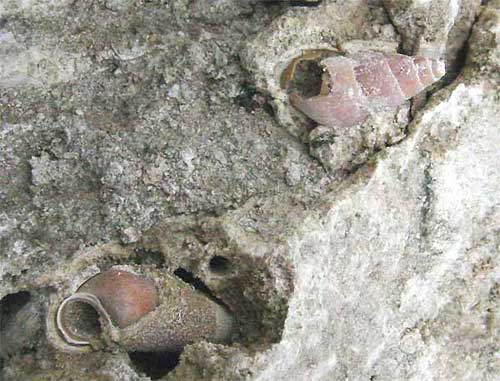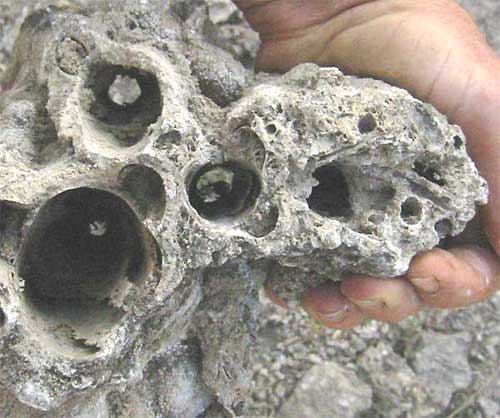Excerpts from Jim Conrad's
Naturalist Newsletter
from the February 24, 2008 Newsletter written in the community of 28 de Junio, in the Central Valley 8 kms west of Pujiltic, elev. ~700m (2300ft), ~N16.331°, ~W92.472°; southeastern Chiapas state, MÉXICO
LOCAL GEOLOGY
I've not said much about local geology because I don't understand it. Before I came here I read that many experts find it hard to interpret, too, about the only thing everyone agreeing on being that it's very complex, mostly limestone, and that the rocks range from extremely old to very recent in age.
A trench has been dug right through the middle of the community in anticipation of laying a pipeline, so a good bit of bedrock has been piled near my dwelling. It's amazingly fossiliferous, and the fossils strike me as very recent -- maybe from the Pleistocene (Ice Age) or even more recent.

Some rock is fairly well consolidated with typical mollusk fossils, as shown above.

Above you can see rock that's almost entirely composed of cemented-together fossil plant-stems, mollusks and pebblelike things. Sometimes the plant-stems were sizable, leaving tunnels upon decomposition, as shown below. With a handlens you can see imprints of neatly aligned plant-cells lining the tunnels' walls.

I'm visualizing the last two rock-types as having been formed when our very carbonate-rich water flooded through a swamp occupying the flat terrace on which presently the community is perched. Today you can find exposed living tree roots at the edges of canals encased in 1/8-inch thick layers of carbonate, so it's easy to imagine marsh plants in the recent past quickly becoming coated with carbonate and getting cemented together. Maybe there was a big flood upslope, or maybe a river changed its course, momentarily running across our terrace.
If anyone out there has more insight into the process I'd like to hear from them. You can write to me at www.backyardnature.net/j/writejim.htm.